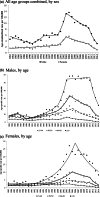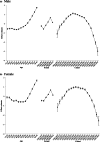Trends in pesticide suicide in South Korea, 1983-2014
- PMID: 30885286
- PMCID: PMC8063219
- DOI: 10.1017/S2045796019000118
Trends in pesticide suicide in South Korea, 1983-2014
Abstract
Aims: Self-poisoning using pesticides is among the major methods of suicide worldwide, and accounts for one-fifth of suicides in 2006-2010 in South Korea. We investigated long-term trends in pesticide suicide rates in South Korea and factors related to these trends.
Methods: We calculated age-standardised rates of pesticide suicide in South Korea (1983-2014) using registered death data. We used graphical approach and joinpoint regression analysis to examine secular trends in pesticide suicide by sex, age and area, and a time-series analysis to investigate association of pesticide suicide rate with socioeconomic and agriculture-related factors. Age, period and cohort effects were examined using the intrinsic estimator method.
Results: Age-standardised rate of pesticide suicide fluctuated between 1983 and 2000 before it markedly increased in 2000-2003 (annual percent change 29.7%), followed by a gradual fall (annual percent change -6.3%) in 2003-2011. Following the paraquat ban (2011-2012), there was a marked reduction (annual percent change -28.2%) in 2011-2014. Trend in pesticide suicide was associated with divorce rate but not with other factors studied. Declines in pesticide suicide in 2003-2011 were most noticeable in younger groups and metropolises; by contrast, elderly adults aged 70+ living in rural areas showed an upward trend until after the 2011-2012 paraquat ban, when it turned downward. In the age-period-cohort modelling, having been born between 1938 and 1947 was associated with higher pesticide suicide rates.
Conclusions: Pesticide suicide trend changed substantially in South Korea over the last three decades. Effective prevention should include close monitoring of trends and strong regulations of toxic pesticides.
Keywords: Elderly; epidemiology; risk factors; suicide.
Conflict of interest statement
None.
Figures



Similar articles
-
Impact of paraquat regulation on suicide in South Korea.Int J Epidemiol. 2016 Apr;45(2):470-9. doi: 10.1093/ije/dyv304. Epub 2015 Nov 18. Int J Epidemiol. 2016. PMID: 26582846
-
Potential underestimation of pesticide suicide and its impact on secular trends in South Korea, 1991-2012.Inj Prev. 2016 Jun;22(3):189-94. doi: 10.1136/injuryprev-2015-041781. Epub 2015 Nov 11. Inj Prev. 2016. PMID: 26559145
-
Factors associated with the decline in suicide by pesticide poisoning in Taiwan: a time trend analysis, 1987-2010.Clin Toxicol (Phila). 2012 Jul;50(6):471-80. doi: 10.3109/15563650.2012.688835. Epub 2012 May 25. Clin Toxicol (Phila). 2012. PMID: 22624660
-
Suicide by pesticide poisoning in India: a review of pesticide regulations and their impact on suicide trends.BMC Public Health. 2020 Feb 19;20(1):251. doi: 10.1186/s12889-020-8339-z. BMC Public Health. 2020. PMID: 32075613 Free PMC article. Review.
-
How many premature deaths from pesticide suicide have occurred since the agricultural Green Revolution?Clin Toxicol (Phila). 2020 Apr;58(4):227-232. doi: 10.1080/15563650.2019.1662433. Epub 2019 Sep 9. Clin Toxicol (Phila). 2020. PMID: 31500467 Review.
Cited by
-
Age, period, and cohort effects on suicide death in the United States from 1999 to 2018: moderation by sex, race, and firearm involvement.Mol Psychiatry. 2021 Jul;26(7):3374-3382. doi: 10.1038/s41380-021-01078-1. Epub 2021 Apr 7. Mol Psychiatry. 2021. PMID: 33828236 Free PMC article.
-
Pesticide poisoning in Zhejiang Province, China: a retrospective analysis from 2008 to 2022.BMC Public Health. 2025 Apr 12;25(1):1378. doi: 10.1186/s12889-025-22604-8. BMC Public Health. 2025. PMID: 40221692 Free PMC article.
-
Self-poisoning with pesticides in Jiangsu Province, China: a cross-sectional study on 24,602 subjects.BMC Psychiatry. 2020 Nov 23;20(1):545. doi: 10.1186/s12888-020-02882-9. BMC Psychiatry. 2020. PMID: 33225936 Free PMC article.
-
The relative importance of macro versus micro geographical scale in explaining suicide variation in Seoul, South Korea 2014-2016.PLoS One. 2022 Sep 9;17(9):e0273866. doi: 10.1371/journal.pone.0273866. eCollection 2022. PLoS One. 2022. PMID: 36084084 Free PMC article.
-
Suicide Overall and Suicide by Pesticide Rates among South Korean Workers: A 15-Year Population-Based Study.Int J Environ Res Public Health. 2019 Dec 3;16(23):4866. doi: 10.3390/ijerph16234866. Int J Environ Res Public Health. 2019. PMID: 31816899 Free PMC article.
References
-
- Ahmad OB, Boschi-Pinto C, Lopez AD, Murray CJL, Lozano R and Inoue M (2001) Age standardization of rates: a new WHO standard. Available at http://www.who.int/healthinfo/paper31.pdf (Accessed 29 January 2019).
-
- Ben Park BC and Lester D (2006) Social integration and suicide in South Korea. Crisis 27, 48–50. - PubMed
-
- Cha ES, Jeong M and Lee WJ (2014b) Agricultural pesticide usage and prioritization in South Korea. Journal of Agromedicine 19, 281–293. - PubMed
MeSH terms
Substances
LinkOut - more resources
Full Text Sources
Medical

